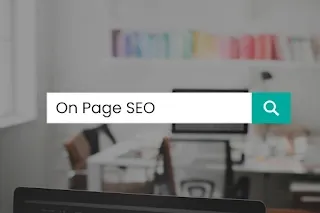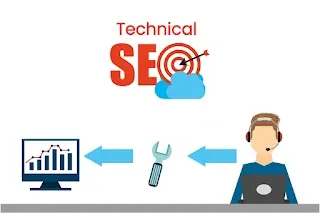In this guide, we’ll explore the essential SEO best practices you need to implement, covering On-Page SEO, Technical SEO, and Off-Page SEO strategies. By the end, you’ll have a clear roadmap to improving your website’s ranking and driving organic traffic.
1. Understanding SEO: Why It Matters
SEO isn’t just about ranking higher; it’s about reaching the right audience, improving user experience, and increasing conversions. When done correctly, SEO helps you:
- Gain organic traffic without paying for ads.
- Build credibility and trust with your audience.
- Improve user experience and website usability.
- Generate more leads and sales.
Now, let’s dive into the three key aspects of SEO: On-Page SEO, Technical SEO, and Off-Page SEO.
On-Page SEO refers to optimizing individual pages to rank higher in search engines. It includes optimizing content, meta tags, images, and internal linking. Here’s how you can do it:
Your title tag and meta description are the first things users see on search engine results pages (SERPs). A well-optimized title should:
- Include your primary keyword.
- Be engaging and click-worthy.
- Stay within 50-60 characters.
Example:
Bad: SEO Tips to Help You Rank
Good: SEO Best Practices: The Ultimate Guide to Ranking Higher in Search Engines
The meta description should provide a brief summary of your content (150-160 characters) and encourage users to click.
2.2 Keyword Optimization: Use Keywords Strategically
Using primary, secondary, and long-tail keywords naturally throughout your content improves rankings. Avoid keyword stuffing—instead, place keywords strategically in:
- Title tags
- Headers (H1, H2, H3)
- First 100 words
- URL structure
- Image alt text
2.3 Improve Content Quality and Readability
Search engines love high-quality, engaging, and informative content. To ensure this:
- Write long-form content (1500+ words for better rankings).
- Use short paragraphs and bullet points for readability.
- Add images, infographics, and videos to enhance user experience.
Large images can slow down your site, affecting rankings. Optimize images by:
- Compressing them using tools like TinyPNG.
- Using descriptive alt text.
- Naming files with relevant keywords (e.g., on-page-seo-tips.jpg).
2.5 Internal Linking: Strengthen Your Website Structure
Linking to other relevant pages within your website:
- Improves navigation and user experience.
- Helps search engines crawl and index your pages.
- Passes link authority to important pages.
Example: If you're writing about SEO best practices, link to related topics like Technical SEO checklist or Off-Page SEO strategies.
2.6 Improve User Experience (UX) and Engagement
Google favors websites with low bounce rates and high engagement. Improve UX by:
- Using clear CTAs (Call to Actions) to guide users.
- Ensuring mobile-friendliness (responsive design is a must).
- Reducing intrusive pop-ups.
Technical SEO focuses on optimizing the backend of your website to improve rankings. Here’s how:
3.1 Improve Website Speed
A slow website frustrates users and leads to higher bounce rates. Improve speed by:
- Enabling browser caching.
- Compressing images and minifying CSS, JavaScript, and HTML.
- Using a fast hosting provider and CDN (Content Delivery Network).
3.2 Mobile-Friendly Optimization
With over 60% of searches happening on mobile, Google prioritizes mobile-friendly websites. Ensure:
- Your site is responsive and adapts to different screen sizes.
- Buttons are clickable and text is readable without zooming.
- Test using Google’s Mobile-Friendly Test Tool.
3.3 Fix Broken Links and Redirects
Broken links create a bad user experience and affect rankings. Use tools like Google Search Console to:
- Identify and fix 404 errors.
- Set up 301 redirects for removed pages.
3.4 Secure Your Site with HTTPS
Google prioritizes secure websites (HTTPS over HTTP). An SSL certificate protects your site and boosts rankings.
Off-Page SEO involves strategies that happen outside your website to improve rankings.
4.1 Link Building: Get High-Quality Backlinks
Backlinks from high-authority sites signal to Google that your content is valuable. Strategies include:
- Guest posting on industry blogs.
- Broken link building (finding and replacing dead links with yours).
- HARO (Help a Reporter Out) for press mentions.
4.2 Social Media and SEO
While social signals don’t directly impact rankings, they increase visibility. Share your content on:
- Twitter (X)
- Reddit and industry forums
4.3 Local SEO and Google My Business Optimization
For local businesses, Google My Business (GMB) is critical. Optimize it by:
- Adding accurate business information.
- Encouraging customer reviews.
- Posting updates and offers.
5. SEO Trends to Watch in 2024
SEO is constantly evolving. Stay ahead with these trends:
- AI-driven content & search algorithms.
- Voice search optimization (long-tail keywords, natural language search).
- Core Web Vitals (Google’s page experience update).
6. Conclusion: Take Action for SEO Success
SEO is a long-term strategy, but implementing these best practices will significantly improve your website’s rankings. Here’s a quick SEO checklist to follow:
- Optimize your title tags, meta descriptions, and content.
- Improve page speed and mobile responsiveness.
- Build high-quality backlinks through outreach and guest posting.
- Keep an eye on SEO trends and Google algorithm updates.
By applying these strategies consistently, your website will not only rank higher but also attract quality traffic and conversions.





.png)



.png)







0 Comments